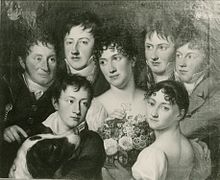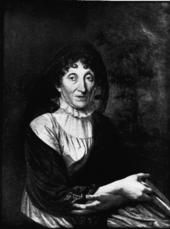Wilhelmine from and to Westerholt-Gysenberg
Countess Anna Maria Wilhelmine von und zu Westerholt-Gysenberg (Wilhelmine was the nickname) (* July 24, 1773 or 1774 or 1775 at Schloss Berge ; † November 3, 1852 in Münster ) was a childhood sweetheart of Beethoven and later Freiin Wilhelmine von Beverförde-Werries and is therefore, with her husband Friedrich Clemens von Elverfeldt zu Dahlhausen and Steinhausen, the founder of the house of Elverfeld called von Beverförde zu Werries .
family
Maria Anna Wilhelmine von Westerholt-Gysenberg was the daughter of Wilhelmine Friderike Franziska Anna Freiin von und zu Westerholt and Gysenberg (1757-1820) and her husband Ludolf Friedrich Adolf von Boenen zu Berge (* 1747 in Buer; † 1828 in Münster). This was raised in 1790 by the elector Karl-Theodor von Pfalz-Bayern to the count status on the condition that he bears the name Westerholt by marrying Franziska Wilhelmina Freifrau zu Westerholt. The marriage, which was founded to keep the Westerholt and Gysenberg families alive , was concluded in 1769. The marriage had four children. The son Friedrich Otto was later Fideikommissar on Westerholt. Wilhelm's older brother Maximilian Friedrich (heir) was from 1806 to 1808 as head stable master in the service of Joachim Murat , Napoleon's brother-in-law and his governor in the Grand Duchy of Berg . . Wilhelm Ludwig was district administrator of the Recklinghausen district from 1816 to 1829 and Maria Anna Wilhelmine.
Relationship with Beethoven
The music lesson
In the summer of 1790 Beethoven accompanied the von Westerholt family to Westphalia . In Westerholt Castle and the family's city palace, the so-called Westerholtschen Hof in Münster , he gave Anna lessons on the piano. In the winter of 1790/91 the family stayed in Bonn for some time. Maria Anna Wilhelmine, who was 16 at the time, was particularly fond of the twenty-year-old musician. The family loved music: the count played the bassoon, his son the flute and his daughter Maria Anna Wilhelmine the piano. Ludwig van Beethoven composed chamber music especially for the three, such as the trio for piano, flute and bassoon in G major work without opus number 37 . With Beethoven's help, Anna carried out many benefit concerts in Bonn and Münster and made a name for herself with them. Christian Gottlob Neefe heard in Münster how she played a difficult sonata by Giuseppe Sardi (Neefe expressly warns against confusion with Giuseppe Sarti ) with admirable speed and effortless ease.
“We shouldn't be surprised that Beethoven's talent was recognized and valued in this musical family. He became the young lady's teacher; and since the head stable master, Count Westerholt, had to accompany the elector on his travels to Munster, where he also owned a house, according to a family tradition, the young Beethoven was once with the family in Munster, before he got married of the young lady, around 1790. It was she and no other who Beethoven was glowing for at the time. This time his passion was intense; nor did he hide it; "
The unpublished lost sonata
During lessons and making music together, the two are said to have come closer than the etiquette allowed. But the countess, who was born, rejected the unknown musician, who was not in keeping with his class, with the words “I am the daughter of my parents”. Beethoven is said to have dedicated a piano sonata to her as a token of his affection. There is no evidence to support the assumption that the young Beethoven tore it up on the same day, although the sonata has never been found. According to witnesses, the as yet unpublished composition was in Ostbevern at Loburg Castle and was lost in the castle fire on July 22, 1899, although it was stored in a safe. Interestingly, Beethoven's writings were found as a draft of a letter to an unknown addressee.
“I have the honor of <sending> you the qintet here , and you will bond me very much if you consider it an insignificant gift from me, the only condition I have to make is that you do not give it to anyone else. you don't get unwilling if I thank you several times, really recommend [...] "
Gustav Nottebohm suspects Count Anton Georg Apponyi to be the addressee and thinks it is the piano quintet op.16, which he probably designed in Berlin in 1796 because the text is on a note paper that Beethoven acquired in Berlin in May or June 1796. In any case, this draft letter, for which the exact date remains unknown - it cannot, however, have been written before 1796 - shows that Beethoven did send small compositions as an intimate gift to dear people.
Enthusiastic romance or tragic love?
To this day there is speculation about the alleged love between Beethoven and Anna von Westerholt, but she is not one of the candidates for his Immortal Beloved . Since hardly any written sources have survived, the question of whether it was real love or just a youthful romance will probably remain unanswered. Beethoven knew the young Comtesse from 1786, when she was twelve and he was fifteen, until she married in 1792. In his letter, he calls her “ ma très chere amie ” (in English my very dear friend ), which is more for an intimate friendship that speaks for real love. His childhood friend Franz Gerhard Wegeler , on the other hand, wrote a few years later about Beethoven's first love from a Fräulein v. W. - leaving it in the unknown which person he meant:
“This was followed by the most loving affection for a beautiful and kind Miss v. W., about which Werther love Bernhard Romberg told me anecdotes three years ago. These love affairs, however, fell into the transitional age and left just as few deep impressions as they had aroused them on the beautiful. "
That Bernhard Romberg reports about it is not surprising, because after all, the Romberger Hof , the domicile of the music-loving Romberg family, is located directly next to the Westerholtscher Hof in Münster , on the site of today's Münster Theater , where Beethoven stayed with the Westerholt family in the summer of 1790 Has. Wegeler also reminded Beethoven in a letter almost 30 years later of his youth and equated Westerholt with Johanna von Honrath :
"Kblz [Koblenz] 1/2 1827 My dear old friend, From the sending of some music from Schott in Meinz, we have become convinced that you will remember with good friendship. Your stubborn silence on my last letters almost made me fear the opposite. Now I say to myself: you didn't want a hard-working correspondent. And yet no one would have taken you back to your youth, remembered a hundred more funny and sad characters than I, especially since my wife, faithful to my memory through stories from Fraulein Westerhold, Jeannette Hohnrath , and what they were all called et ceteras helps. "
Ostbevern
On April 24, 1792 Anna married Freiherr Friedrich Clemens von Elverfeldt zu Dahlhausen and Steinhausen in Telgte , to whom she gave four sons and a daughter: Carl, Friedrich, Max, Wilhelm and Wilhelmina. She stayed at Loburg Castle in Ostbevern until her death and was buried in the Anna Chapel named after her at the side of her husband. A painting of her with her family, which was made by Johann Christoph Rincklake , is still in the possession of the von Beverförde family in Ostbevern today.
literature
- Robert Bory: Ludwig van Beethoven. His life and work in pictures. Zurich 1960.
- Lewis Lockwood: Beethoven. His music - his life. Stuttgart 2009. ISBN 3-476-02231-5 .
- Malte Korff: Ludwig van Beethoven. Berlin 2010. ISBN 3-518-18246-3 .
Web links
- unfilled love
- local compass
- Pictures by Anna von Westerholt in the Beethovenhaus
- Facsimile in the Beethovenhaus
- Original text on the website of the Beethoven-Haus Bonn (PDF file; 61 kB)
- Sound examples for WoO 37 on YouTube: 1st movement , 2nd movement , 3rd movement
Individual evidence
- ↑ Martin Blindow, The relationships between the court orchestras in Bonn and Münster at the end of the 18th century , in: Bonner Beethoven Studies , Volume 9, pp. 53–88, here p. 81 (gives the date of birth 1773 without the exact date)
- ↑ Alexander Wheelock Thayer , Ludwig van Beethovens Leben , 3rd edition, Leipzig 1916, Volume 1, p. 284 (gives as date of birth 1774 with exact date)
- ↑ from Liber status animarum (Latin literally: Book of the condition / inventory of the living) Ostbevern Pastor Spithöver 1608 ff Ostbevern parish archive.
- ↑ from Liber status animarum (Latin literally: Book of the condition / inventory of the living) Ostbevern Pastor Spithöver 1608 ff Ostbevern parish archive. see picture on talk page
- ↑ Chamber music in the Westerholt House
- ^ Siegfried Schmieder: Ostbevern - Contributions to History and Culture, History of Loburg, Warendorf 1988, p. 570
- ^ Christian Gottlob Neefe: Berlinische Musikalische Zeitung. Eight and thirty-eighth piece, October 19, 1793, in: Berlinische Musikalische Zeitung (edited by Carl Walk) Berlin 1794, pp. 150/151 .
- ↑ Alexander Wheelock Thayer , Ludwig van Beethovens Leben , 3rd edition, Leipzig 1916, Volume 1, p. 284
- ↑ ibid
- ^ Siegfried Schmieder: Ostbevern - Contributions to History and Culture, History of Loburg, Warendorf 1988, p. 575
- ^ Sieghard Brandenburg: Ludwig van Beethoven, Briefwechsel Gesamtausgabe, Volume 1 1783–1807, published on behalf of the Beethoven House in Bonn by Sieghard Brandenburg, Munich 1996, p. 31
- ^ Facsimile of the letter in Robert Bory: Ludwig van Beethoven, His life and his work in pictures. Zurich 1960, p. 48.
- ↑ Proof: Schmidt-Görg 41. - SBH 490 Facsimile of the Beethoven House: Schiedermair, Beethoven. Contributions to life and work based on documents from the Beethoven House, Bonn 1930
- ^ Sieghard Brandenburg: Ludwig van Beethoven, Briefwechsel Gesamtausgabe, Volume 6, 1825–1827, published on behalf of the Beethoven-Haus Bonn by Sieghard Brandenburg, Munich 1996, p. 346.
| personal data | |
|---|---|
| SURNAME | Westerholt-Gysenberg, Wilhelmine from and to |
| ALTERNATIVE NAMES | Beverförde-Werries, Maria Anna Wilhelmine from |
| BRIEF DESCRIPTION | Beloved of Beethoven |
| DATE OF BIRTH | July 24, 1774 |
| DATE OF DEATH | November 3, 1852 |
| Place of death | Muenster |

